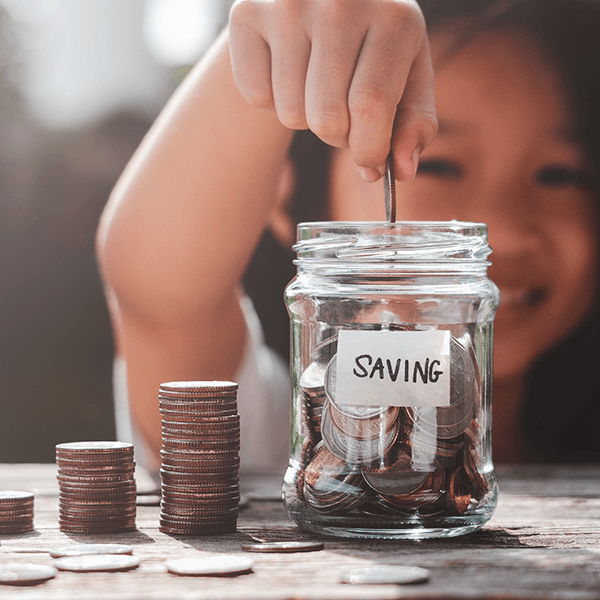Children's savings guide
The earlier you start saving for your children, the more help they will have going into adulthood.
Savings can help your children pay for the important stuff – going to university, buying their first home, or even funding a gap year. But getting kids involved in saving is also a good way to teach them about money.
How you save for your child's future is up to you, and there are plenty of options available. Read on to find out about:

How different children's savings products compare
Not quite sure how to start saving for your child but leaning towards a specific goal? See how all the options compare and which could be best for you and your child before you delve into the details.
| Junior ISA | Tax Exempt Savings Plan for Children (TESP) | Child Savings Account | Adult ISA | Child's pension | |
|---|---|---|---|---|---|
| Do you have to pay tax on the money you withdraw? | No | No | Potentially, depending on how much the money has grown. | No | Yes |
| Who can open one? | The child's parent or legal guardian | Anyone over the age of 18 | Anyone | Anyone over the age of 18 | The child's parent or legal guardian |
| How much can you pay in? | Up to £9,000 each tax year | Between £15 and £25 a month, or between £165 and £270 each tax year | However much you like | Up to £20,000 each tax year | Up to £2,880 each tax year (£3,600 with tax relief) |
| Who can access the money? | Only the child the junior ISA is meant for | Only the child the TESP is meant for | Both the parent and the child, at any time | Only the Adult ISA owner | Only the child the pension is meant for |
| When and how does the child get the money? | On their 18th birthday, but they can manage their account when they turn 16 | At the end of the payment term, which can be anywhere between 10 to 25 years | The child can access the money at any time from the age of seven | When the Adult ISA owner withdraws the money, they can give it to the child | Only when they can access their pensions (currently age 55) |
| Best for | Saving or investing for adulthood | Saving or investing for a special day | Helping your child learn about money | Saving more than £9,000 each tax year | Helping your child prepare for retirement |
| Do you have to pay tax on the money you withdraw? | |
|---|---|
| Junior ISA No |
Tax Exempt Savings Plan for Children (TESP) No |
| Child savings account Potentially, depending on how much your money has grown |
Adult ISA No |
| Child's pension Yes |
|
| Who can open one? | |
|---|---|
| Junior ISA The child's parent or legal guardian |
Tax Exempt Savings Plan for Children (TESP) Anyone over the age of 18 |
| Child savings account Anyone |
Adult ISA Anyone over the age of 18 |
| Child's pension The child's parent or legal guardian |
|
| How much can you pay in? | |
|---|---|
| Junior ISA Up to £9,000 each tax year |
Tax Exempt Savings Plan for Children (TESP) Between £15 and £25 a month, or between £165 and £270 each tax year |
| Child savings account However much you like |
Adult ISA Up to £20,000 each tax year |
| Child's pension Up to £2,880 each tax year (£3,600 with tax relief) |
|
| Who can access the money? | |
|---|---|
| Junior ISA Only the child the junior ISA is meant for |
Tax Exempt Savings Plan for Children (TESP) Only the child the TESP is meant for |
| Child savings account Both the parent and the child, at any time |
Adult ISA Only the Adult ISA owner |
| Child's pension Only the child the pension is meant for |
|
| When and how does the child get the money? | |
|---|---|
| Junior ISA On their 18th birthday, but they can manage their account when they turn 16 |
Tax Exempt Savings Plan for Children (TESP) At the end of the payment term, which can be anywhere between 10 to 25 years |
| Child savings account At any time from the age of seven |
Adult ISA When the Adult ISA owner withdraws the money, they can give it to the child |
| Child's pension Only when they can access their pensions (currently age 55) |
|
| Best for | |
|---|---|
| Junior ISA Saving or investing for adulthood |
Tax Exempt Savings Plan for Children (TESP) Saving or investing for a special day |
| Child savings account Helping your child learn about money |
Adult ISA Saving more than £9,000 each tax year |
| Child's pension Helping your child prepare for retirement |
|
Junior ISAs
Junior ISAs were introduced in 2011 to replace the government-subsidised child trust fund (CTF) scheme. Unlike CTFs, junior ISAs do not include an initial government payment, but, like CTFs, they're long-term, tax-free savings accounts for children.
There are two types of junior ISA - ones that save in cash and ones that invest in stocks and shares. A child can have both a cash and a stocks and shares junior ISA, and up to £9,000 can be contributed towards them - in total - each tax year.
Junior ISAs can be transferred between providers if needed and you can also transfer a child trust fund into a junior ISA.
Your child can take over their account when they turn 16, meaning they can make their own investment decisions and transfer between providers, but they can’t take any money out until they turn 18.
At that point it's entirely up to them how they use the money.
At age 18, junior ISAs automatically become adult ISAs and retains their tax-free status. Because they mature when the child reaches 18, junior ISAs can be a good way of giving your child a boost into adulthood.

Junior ISA
With our stocks and shares Junior ISA you can start investing from just £10 a month and save up to £9,000 each year on behalf of a child. Anyone can pay in and the child will be able to withdraw the money in the account once they turn 18.

How much could you help your child save with a OneFamily Junior ISA?
Decide how much you'd like to pay into your child's Junior ISA each month and our simple Junior ISA calculator will quickly give an idea of how your their money could grow.
The projection shows how your child's Junior ISA could grow with low, medium and high growth scenarios. Remember, projections are not a guarantee of future performance and your child could get back less than you pay in.
It's worth remembering that the value of stocks and shares can fall as well as rise. This is normal for this type of investment, but your child could get back less than has been paid in.
Tax Exempt Savings Plans
Tax Exempt Savings Plans (TESPs) are investment products that are only offered by friendly societies.
TESPs are different from savings accounts and ISAs because you choose how long you want to invest for when you open the account, from 10 to 25 years, and you’ll make regular payments over this time.
You can save between £15 and £25 a month or between £165 and £270 a year into a TESP for a child and when the policy matures your child receives a tax-free lump sum. As the name suggests, you won't pay any tax no matter how much your money grows, as long as you’ve kept up these payments.
Find out more: Junior ISAs vs Tax Exempt Savings Plans for children

Child savings accounts
Child savings accounts are designed specifically for children. They’re simple cash accounts that grow by building interest. Broadly speaking there are two main types:
- Easy-access or instant-access savings accounts
- Regular savings accounts
They can be opened with banks or building societies for any child up to the age of 18. The minimum you need to open a child savings account is £1.
Their main purpose is to help children learn about saving and money management as the money in the account can be accessed by the child at any time.
Find out more: Junior ISAs vs child savings accounts
Easy-access and instant-access child savings accounts
These two types of child savings accounts are every similar, they both let children withdraw money either immediately or very quickly.
If you want to involve your child in the saving and spending process then an easy-access savings account could be a good choice.
However, make sure you check the rules on the account as some providers may limit how many times you can take money out or offer lower interest rates if you do so often.
These types of accounts tend to have lower interest rates overall than regular savings accounts.
Regular child savings accounts
Regular child savings accounts are geared towards more regular saving.
You have to deposit money into the account at least once a month and it can take longer to make withdrawals from than easy-access child savings accounts.
They usually have a higher interest rate than easy-access child savings accounts, but if you miss some of your monthly payments the interest rate could go down so make sure you check.

Other options
Your own ISA
Saving for your children in your own cash or stocks and shares ISA could be an attractive alternative to a junior ISA. With the current annual ISA limit standing at £20,000, it’s possible to save or invest more for your children than in a junior ISA – but this will mean limiting the amount you can save for yourself.
While the tax benefits are the same as for junior ISAs, money can be withdrawn from a standard ISA at any time – which could be a good or a bad thing, depending on your point of view. If you are saving for your children’s school fees, for example, you may need to have access at a much earlier age than 18.
The ISA doesn’t become the legal property of your child at any point, which might work better for you if you have concerns that the money might not be used wisely.
Find out more: What are the differences between junior ISAs and adult ISAs?
Advantages:
- No tax paid on any returns, whether that’s interest in a cash ISA or from investments in a stocks and shares ISA.
- The annual limit for your ISA is £20,000, which is higher than a junior ISA’s £9,000 annual limit.
- If your child needs the money before they turn 18, you can withdraw it, while in a junior ISA the money is locked in until the child turns 18.
Disadvantages:
- The money isn’t locked in for the child, meaning the savings could be dipped into over time.
- It counts as part of your own ISA allowance, so there’s less room for you to save for yourself.
Child’s pension
If you want to take a really long-term approach, you could consider setting up a pension for your child – perhaps alongside one of the other options on this list.
You can save up to £3,600 a year on a child’s behalf in a self-invested personal pension (SIPP). Because tax relief can be claimed on pension contributions, you can save this much but only actually pay £2,880 (or £240 a month), because you’ve already paid tax on the money you pay in so this gets paid back by HMRC.
It's worth noting that child pensions take the child's tax allowance into account, not the parent's, so even if you pay more than 20% income tax (for example, if you're in a higher income bracket where you pay 40% tax) your child won't get more than 20% in tax relief.
In general, children’s pensions are designed to be invested in the stock market and related assets. Like any other pension, the money can’t be accessed – without incurring significant tax penalties – before the age of 55. Your child could get considerable returns for having their money locked away for 50 years or more, but those returns aren’t guaranteed.
Advantages:
- Tax relief is paid on contributions.
- There's good potential for the money to grow since it's invested for a long time.
Disadvantages:
- The money can’t be accessed until age 55, which means it probably can’t be used for university fees or a first property purchase.
- The tax treatment of pensions may change in a negative way in the future.
Frequently asked questions about saving for children
What would you like to do next?
Open a Junior ISA
Give your kids a head start in life with our tax-exempt stocks and shares Junior ISA.
Transfer a Junior ISA account
Transferring a Junior ISA to us is simple, and we won't charge you for making the change. Find out more and get started here.
Transfer a Child Trust Fund
Transfer a Child Trust Fund to a OneFamily Junior ISA. You can be sure your child's money is in experienced hands.
